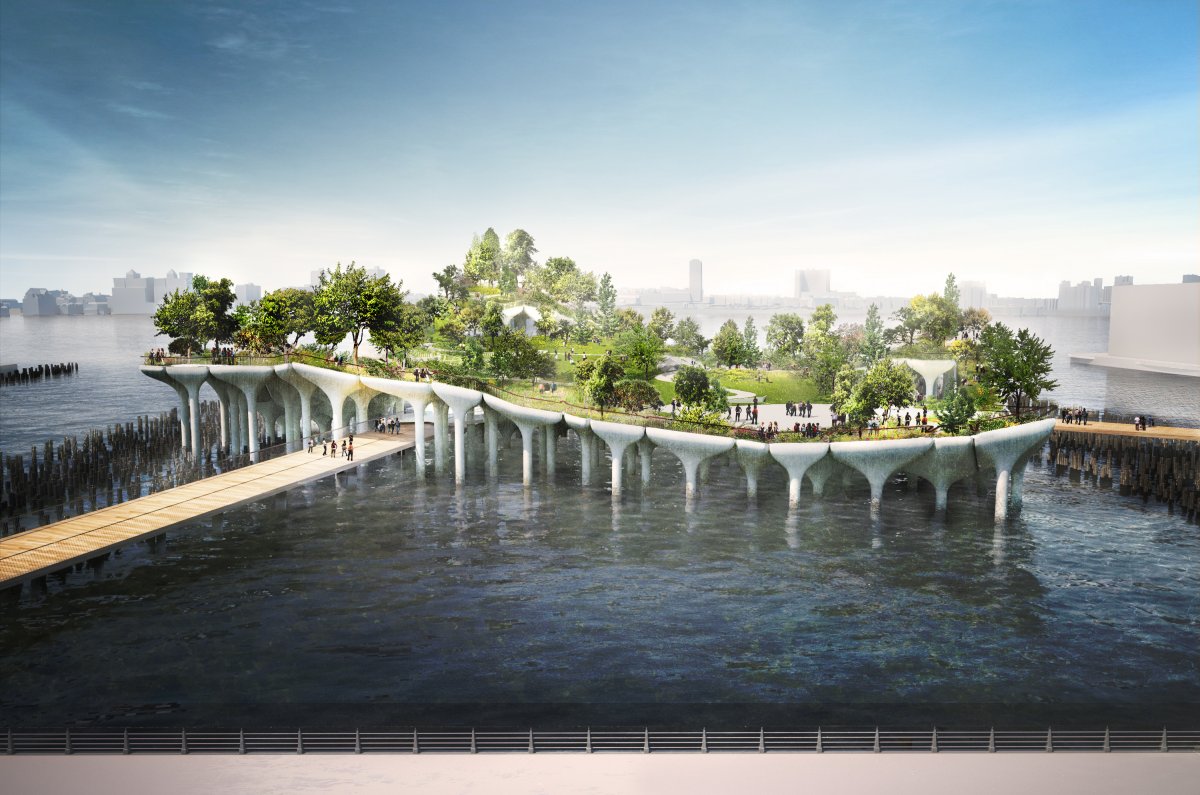The Hudson River Park Trust in New York City voted unanimously on Feb. 11 to approve a plan to build a $130 million pier, with lush greenery and an outdoor performance space, on the Hudson River, according to Business Insider.
The so-called “floating park” is the brainchild of billionaire mogul Barry Diller and his wife, the fashion designer Diane von Furstenberg. The 2.4-acre park, officially called Pier 55, will rise out of the river, 186 feet from its shorelines, near West 14th Street. Various news reports, including one posted on the website DNAinfo.com, state that the park is scheduled to open to the public sometime in 2019.
Diller, the chairman of IAC/InterActiveCorp, will contribute $113 million for construction, and will finance the park’s maintenance for 20 years. The city is kicking in $17 million, and the state will provide $18 million toward an expanded public esplanade between Bloomfield and 14th streets.
Diller’s largesse is the single biggest private donation to a public park in New York’s history, according to Capital New York, eclipsing a $100 million gift that hedge fund manager John Paulson bestowed on the Central Park Conservatory in 2012.
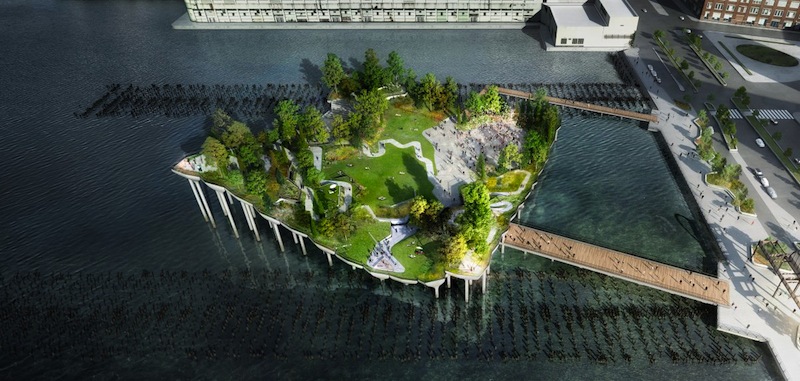
More than half of the performances held at the pier’s 700-seat amphitheater will be free or low-cost, according to a 20-year lease awarded to Diller’s P55 nonprofit organization. (That lease includes an option to renew for another 10 years.)
Diller told Capital New York that the nonprofit would produce works “across all forms of performance—musical, musical comedy, concert, pop concert, spoken theatrical play, ballet, etc.” P55’s board members include the film and theater producer Scott Rudin, movie director Stephen Daldry, and theater director George Wolfe,
To deflect criticism that this is just another land grab by a rich entrepreneur, the Hudson River Park Trust said it is establishing a community advisory committee comprised of local residents and Manhattan Borough President Gale Brewer, which would consult on the park’s programming and ticket distribution.
The next step will be for the developers to apply for permits form the Army Corps of Engineers and the New York State Department of Environmental Conservation. The goal is for construction to begin next year.
Capital New York reports that Heatherwick Studios has been commissioned to design the floating park. Heatherwick is notable for having built a garden bridge over the Thames River in London. It will work with landscape architect Signe Nielsen, who designed the Tribeca section of the Hudson River Park.
The new pier would replace the existing, albeit crumbling, Pier 54, which once served as one of Hudson River Park’s main performance venues. Capitol New York and the New York Times report that the new pier would stretch 320 feet by 320 feet between Pier 54’s old pile field and the pile field that once supported Pier 56. The parallelogram-shaped pier would be built atop 300 concrete columns that range in height from 15 feet to 62 feet above the water level.

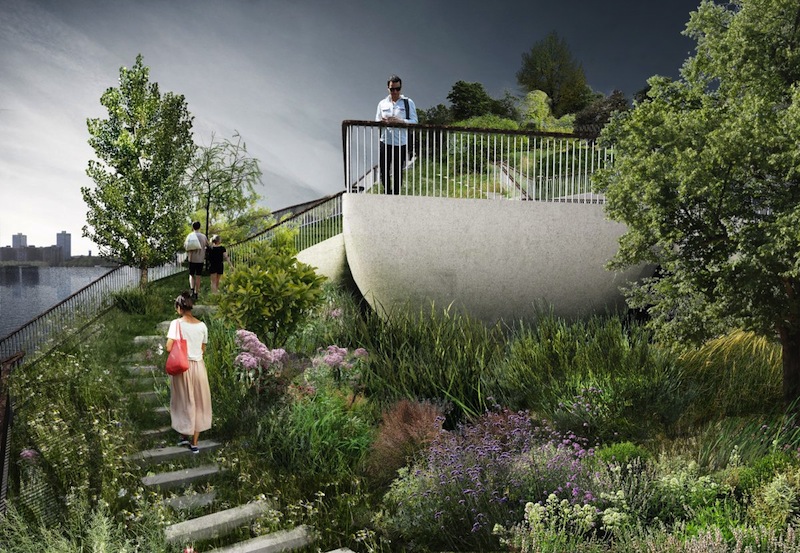
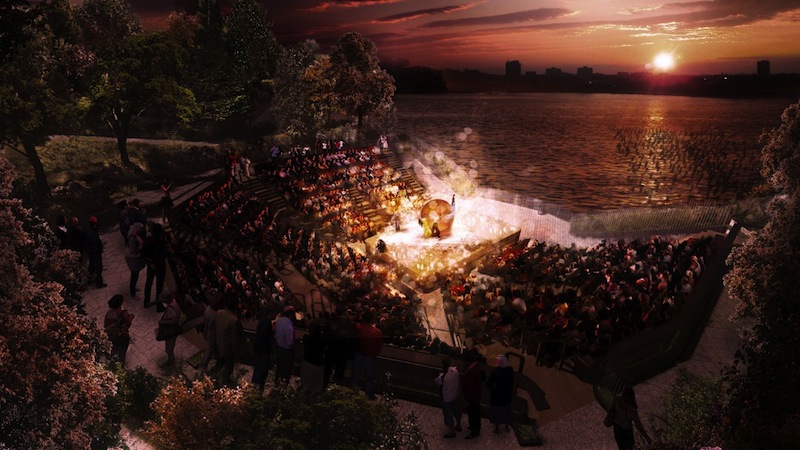
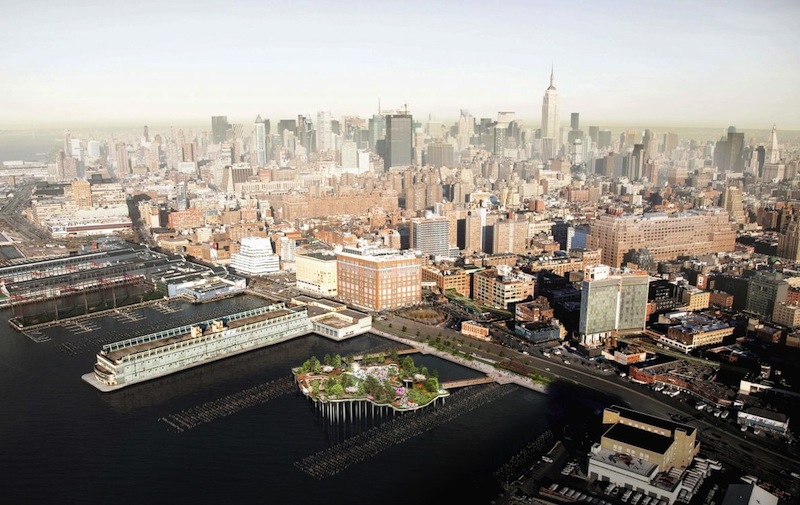
Related Stories
| Aug 11, 2010
Biograph Theater
Located in Chicago's Lincoln Park neighborhood, Victory Gardens Theater Company has welcomed up-and-coming playwrights for 33 years. In 2004, the company expanded its campus with the purchase of the Biograph Theater for its new main stage. Built in 1914, the theater was one of the city's oldest remaining neighborhood movie houses, and it was part of Chicago's gangster lore: in 1934, John Dillin...
| Aug 11, 2010
Top of the rock—Observation deck at Rockefeller Center
Opened in 1933, the observation deck at Rockefeller Center was designed to evoke the elegant promenades found on the period's luxury transatlantic liners—only with views of the city's skyline instead of the ocean. In 1986 this cultural landmark was closed to the public and sat unused for almost two decades.
| Aug 11, 2010
Putting the Metal to the Petal
The Holocaust and Human Rights Center of Maine was founded in 1985, but the organization didn't have a permanent home until May 2008. That's when the Michael Klahr Center, which houses the HHRC, opened on the Augusta campus of the University of Maine. The design, by Boston-based architects Shepley Bulfinch Richardson & Abbott, was selected from among more than 200 entries in a university-s...
| Aug 11, 2010
Jefferson Would Be Proud
The Virginia State Capitol Building—originally designed by Thomas Jefferson and almost as old as the nation itself—has proudly served as the oldest continuously used Capitol in the U.S. But more than two centuries of wear and tear put the historical landmark at the head of the line for restoration.
| Aug 11, 2010
Let There Be Daylight
The new public library in Champaign, Ill., is drawing 2,100 patrons a day, up from 1,600 in 2007. The 122,600-sf facility, which opened in January 2008, certainly benefits from amenities that the old 40,000-sf library didn't have—electronic check-in and check-out, new computers, an onsite coffeehouse.
| Aug 11, 2010
American Tobacco Project: Turning over a new leaf
As part of a major revitalization of downtown Durham, N.C., locally based Capitol Broadcasting Company decided to transform the American Tobacco Company's derelict 16-acre industrial plant, which symbolized the city for more than a century, into a lively and attractive mixed-use development. Although tearing down and rebuilding the property would have made more economic sense, the greater goal ...
| Aug 11, 2010
Bronze Award: Alumni Gymnasium Renovation, Dartmouth College Hanover, N.H.
At a time when institutions of higher learning are spending tens of millions of dollars erecting massive, cutting-edge recreation and fitness centers, Dartmouth College in Hanover, N.H., decided to take a more modest, historical approach. Instead of building an ultra-grand new facility, the university chose to breathe new life into its landmark Alumni Gymnasium by transforming the outdated 99-y...
| Aug 11, 2010
Fleet Library, Rhode Island School of Design
When tasked with transforming an early 1920s Italian Renaissance bank building into a fully functional library for the Rhode Island School of Design, the Building Team for RISD's Fleet Library found itself at odds with the project's two main goals. On the one hand, the team would have to carefully restore and preserve the historic charm and ornate architectural details of the landmark space, d...
| Aug 11, 2010
Gold Award: The Lion House, Bronx Zoo Bronx, N.Y.
Astor Court sits at the heart of the 265-acre Bronx Zoo, and its six Beaux Arts buildings were constructed at the turn of the 20th century to house exotic animals from around the world. When the Lion House was built in 1903, the brick and limestone facility was considered state-of-the-art, but as standards of animal care advanced, the lions were moved into a more natural setting, and the Lion H...
| Aug 11, 2010
The pride of Pasadena
As a shining symbol of civic pride in Los Angeles County, Pasadena City Hall stood as the stately centerpiece of Pasadena's Civic Center since 1927. To the casual observer, the rectangular edifice, designed by San Francisco Classicists John Bakewell, Jr., and Arthur Brown, Jr., appeared to be aging gracefully.


